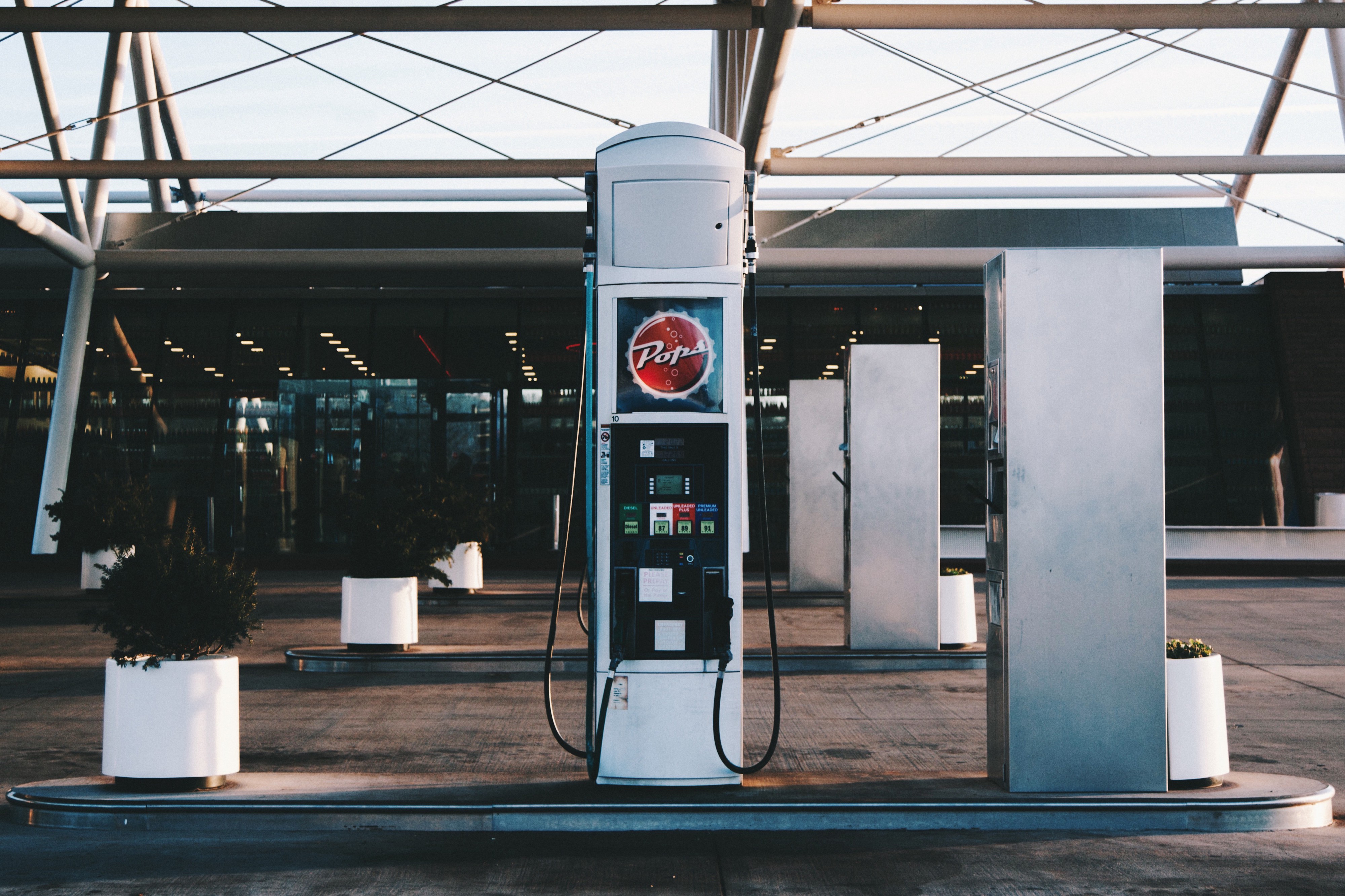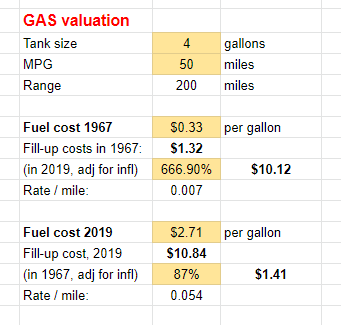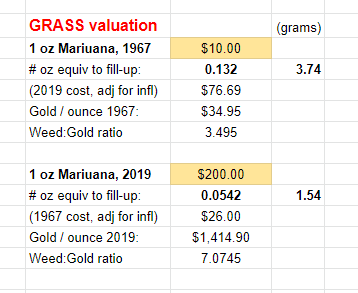 Photo by The Ride Academy on Unsplash
Photo by The Ride Academy on Unsplash
As far back as the 1970s, I recall hearing the phrase ?Gas, Grass, or Ass ? No one Rides for Free.? I?m not certain who first coined the phrase, or if in fact there was a historical author or ordering of the three items deemed acceptable as fare. At some point the words, presumably originating in the biker world, caught on and became a common saying appearing on t-shirts and bumper stickers world-wide.
Whether the saying (usually, one hopes, uttered as a lewd joke) ever represented the literally truthful stance of anyone, I have no idea ? although, having heard all of the lurid tales that I have over my lifetime, my gut is that the saying has some basis in truth. The situation being represented can be boiled down as follows:
- Person A (aka Biker Chick) is in need of transportation. Many related (yet sometimes important, as we?ll see) factors remain unknown ? e.g., the trip?s distance, purpose, urgency, etc. (Even Biker Chick?s weight, technically speaking, is a factor here, as it?ll have an effect on gas mileage.) Other aspects are assumed, though also technically unknown ? e.g., that Biker Chick is (usually) female, and likely the one asking Biker (presumably a man) for the ride.
- Person B (aka Biker) has the transportation (i.e., owns a motorcycle, or possibly some other form of transportation) and is the one uttering this response to Biker Chick?s inquiry. (Or, perhaps there isn?t always an official inquiry per se, and the Biker is simply making his general policy known, in anticipation of any such inquiries).
Right off the bat, I think it?s safe to say that the Biker, if serious ? which surely may well have been the case historically ? is (or was) an asshole, clearly lacking in humanity. But, we?ll not focus on that obvious fact for our purposes.
In the scenario, the Biker presumably dislikes various aspects of any requests for rides. Clearly, he feels inconvenienced at the prospect of a second rider, ostensibly based on the ?cost? that such a second person represents. Some costs may be rooted in actual dollars, such as reduced gas mileage with a second rider (especially relevant in the motorcycle world where the total rider weight to machine ratio would be significantly altered with the addition of a second rider). Other costs may be softer, such as having to accommodate a second person, various tasks or stops possibly taking longer, and who knows what else.
In fairness, a second rider may actually provide some benefits (e.g., safety, companionship, and/or social acceptance), but those aren?t (one imagines) generally figured into the saying.
Quantifying the Fare
I?m not sure anyone?s ever taken a serious look at the math and valuations involved in this scenario. And, to be honest, when I first considered doing it, and began making a mental list, there were simply too many variables to ever get to the bottom of this in an easy, precise way. Some items would require a ton of research. So, I?ll leave it to others to refine my initial thoughts.
First, let?s assume the phrase originated in the 1960s sometime. Let?s go with 1967, the so-called Summer of Love, as that seems as free-wheeling a time as any, with the by-then-well-established Hell?s Angels ingrained into the national consciousness.
I love him but it embarrasses meTo walk down the street with himHe lives in Brooklyn somewhereAnd he wears his white crash helmetHe has golden chains on his leather jacketAnd on the back are written the names?Mary? and ?Mom? and ?Hell?s Angels? ?~from the song ?Frank Mills? out of the musical ?Hair? which debuted in 1967.
What I?m interested in doing here is valuing the three items (gas, grass, ass) in order to compare them and see which one was the best deal in this asinine scenario. Ultimately, the best way to look into all of this is with a spreadsheet, as it?s going to need a lot of modeling to gather assumptions and calculate from them. So, let?s dig in.
1. GAS
 Photo by Caryle Barton on Unsplash
Photo by Caryle Barton on Unsplash
GAS is probably the best place to start here, as it?s the most universal commodity of the three. Right off the bat, when we start looking at the GAS aspect, we realize that so much is unknown.
- Tank size: Some motorcycles have one-gallon tanks, some five-plus. And, I?m sure that?s just a bell-curve estimate there. Let?s start with 4 gallons as a baseline.
- MPG: Looking into motorcycle gas mileage, we see that this also varies widely by model. I ran across internet claims of 1960s motorcycle models approaching 100 mpg. (Is that true? I have no idea!) Oddly, today?s MPG ratings that I saw tended to be lower. I guess MPG isn?t as big of a performance concern, possibly, as it once was. So, let?s start with 50 mpg for our purposes.
- 1967 gas prices: Easy enough. According to some sites, that was $0.33/gallon. Ergo, a 4-gallon fill-up was $1.32, offering a range if 200 miles in this scenario. (That gas expense, btw, according to other stats available online, equates to $10.12 today in 2019).
- 2019 gas prices: As of this writing, it?s $2.71/gallon. Thus, a fill-up costs $10.84 today ? same range of 200 miles. (Pretty consistent pricing there, really.)
 Spreadsheet snapshot.
Spreadsheet snapshot.
In this case, assuming the Biker Chick?s ride was less than 200 miles, that?s a contribution of $1.32 then or $10.84 now (roughly equivalent, factoring for inflation ? about $0.007/mile then vs $0.054/mile now). Unfortunately, we can?t be sure if (a) the ride required a full fill-up for any distance less than the bike?s range, or (b) if a distance greater than the bike?s one-tank range required further fills.
2. GRASS
 Photo by Chase Fade on Unsplash
Photo by Chase Fade on Unsplash
This one?s also difficult to pin down precisely. Looking into historical marijuana prices, little data exists. However, I did find mentions that the term ?dime bag? originally (back in the 1960s) referred to a larger, one-ounce bag of weed, whereas a ?nickel bag? was a half-ounce. The term ?dime? in this case, referred to the then-price of $10.
Of course, we don?t know how much marijuana the Biker required in these scenarios. If it were an ounce, though, that?s a $10 fare as compared to a $1.32 fare had the Biker Chick opted for the GAS option. It?s unknown whether she could have offered the equivalent value, in weed, of a fill-up, which in this case would be 0.132 ounces, or 3.74 grams in 1967.
In today?s strange world, the price of marijuana varies greatly depending on what state you?re in, and whether it?s legal. But, some quick hunting around shows that a fairly decent ballpark guess is $200 per ounce in 2019. Thus, an amount equivalent to today?s fill-up cost would be 0.05 oz, or about 1.5 grams in 2019.
 Spreadsheet snapshot
Spreadsheet snapshot
Deciding on which is better (gas vs. grass), much would depend on the particulars (how many fills, how much weed, etc.). So, let?s move on?
3. ASS
 Photo by Marc Schaefer on Unsplash
Photo by Marc Schaefer on Unsplash
I imagine rates are out there, but was hesitant to actually Google it (though I did, quickly, and in incognito mode, so as not to hopefully associate my Google account w/ a bunch of pervy crap ? though, as an author, one must do the research, and that does lead one toward getting strange ads on Facebook and whatnot pretty regularly).
Anyway? historical data was no where I looked (though, again, I wasn?t going to dig for it). But, I did find a chart that mentioned a going rate of $200 in 2019. So, if we use the same inflationary data as we?ve used so far (via the US Inflation Calculator web site, btw), that $200, today, would /should have run about $26 back in 1967.
The thing is: While gas is easily divisible into gallons and grass easily divisible into ounces or grams, ass isn?t so fractionable, unless one were to differentiate between various acts ? but even then, one imagines, it?s kind of an all-or-nothing value. So, for our model, I think we just have to enter a single number per time period, as shown.
 Spreadsheet snapshot.
Spreadsheet snapshot.
So, $200 today would fill the tank 18.45 times (or almost 20 times in 1967), thus arguably entitling the Biker Chick to a range of 3,690.04 miles today (and 3,939 miles in 1967) ? easily enough to ride from Manhattan to San Francisco.
Of course, the Biker Chick would likely do well to keep in mind the additional potential psychological costs of paying such a fare, as many therapists charge that much per hour (thus the regret may add significantly to the valuation later on).
Conclusions
In the end ? again, speaking strictly on the basis of numbers ? the gas option seems the best deal. Your mileage, as they say, may vary.
If you liked this article, you may also like:
Hypothetical Problem of the Three Superlative Feline Honors
The following is a story I?ve relayed on many a summer?s day relaxing on the back forty with Tuxie Cat, the single-most?
medium.com
?? ?? Jim Dee maintains his personal blog, ?Hawthorne Crow,? and a web design blog, ?Web Designer | Web Developer Magazine.? He also contributes to various Medium.com publications. Find him at JPDbooks.com, his Amazon Author page, Facebook, Twitter, Instagram, LinkedIn, Medium, or via email at Jim [at] ArrayWebDevelopment.com. His latest novel, CHROO, is available on Amazon.com. If you enjoy humorous literary tales, please grab a copy!


